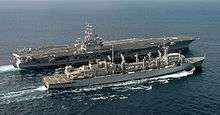USNS Bridge (T-AOE-10)
.jpg) | |
| History | |
|---|---|
| Name: | USNS Bridge (T-AOE 10) |
| Namesake: | Horatio Bridge |
| Ordered: | 6 December 1989 |
| Awarded: | 15 January 1993 |
| Builder: | National Steel and Shipbuilding Company, San Diego County, California |
| Laid down: | 2 August 1994 |
| Launched: | 24 August 1996 |
| Commissioned: | 5 August 1998 |
| Decommissioned: | 29 June 2004 |
| In service: | 29 June 2004 |
| Out of service: | 30 September 2014 |
| Homeport: | Naval Base Kitsap, Bremerton, Washington, U.S. |
| Identification: |
|
| Status: | Inactive as of 2016 |
| General characteristics | |
| Class and type: | Supply class |
| Displacement: | 48,800 long tons (49,600 t) |
| Length: | 754.6 ft (230.0 m) |
| Beam: | 107 ft (33 m) |
| Draught: | 39 ft (12 m) |
| Installed power: | 105,000 hp (78 MW) |
| Propulsion: | four General Electric LM 2500 gas turbine engines, Two Propellers |
| Speed: | 26 knots (48 km/h; 30 mph) |
| Complement: | 176 civilians, 30-45 military |
| Aircraft carried: | Two CH-46E Sea Knight or MH-60S Seahawk helicopters |
USNS Bridge (T-AOE-10), formerly the USS Bridge (AOE-10), is the fourth ship in the Supply class of fast combat support ships and the second ship in the United States Navy named after Commodore Horatio Bridge. Bridge was commissioned on 5 August 1998.
History

1990s
Her commissioning CO was CAPT Robbie Williams (a SWO). The second CO was CAPT (now RADM) Rick Wren. In June 2001, CAPT (later VADM) Carol Pottenger relieved CAPT Wren. Bridge made four deployments as a commissioned warship.
2000s
On 29 June 2004, Bridge was formally decommissioned and transferred from the United States Navy to the Military Sealift Command. Although the transfer to MSC occurred on 29 June 2004, the ceremony took place on 24 June 2004 (which is why the two dates are often interchanged). Bridge no longer carries the weapons systems she had been equipped with. As a commissioned warship, Bridge was equipped with two Phalanx Block 1 CIWS mounts, one NSSM launcher (with two Mk 91 directors), two Mk. 38 25-mm chain guns, six .50 caliber heavy machine gun mounts, and two M-60 mounts (on the bow), in addition to the Beretta M9s, M-14s, and 12-gauge Mossberg shotguns issued to the watch standers.
2010s
In March 2011, in company with the carrier Ronald Reagan, the ship was deployed off northeastern Honshu, Japan to assist with relief efforts after the 2011 Tōhoku earthquake and tsunami.[1] One interpretation of multiple surveys and repeated tests for traces of radiation was suggested to indicate that during that time, the ship was not exposed to any leaking radiation from the Fukushima I nuclear accidents, however, the ship was then quickly decommissioned.[2] Bridge conducted 25 underway replenishment operations, delivering more than 1.8 millions gallons of fuel in support of Operation Tomodachi.[3]
In April 2013, it was announced that the MSC will take USNS Bridge and USNS Rainier (T-AOE 7) out of service in 2014 as a cost-saving measure.[4] The ships' gas turbine propulsion make them faster than other Navy supply ships, but also make them consume more fuel.[5]
As of 2018, USNS Rainier and USNS Bridge are in reserve.[6]
Notes
- ↑ Rabiroff, John. "U.S. military delivers 40 tons of supplies to hardest-hit areas," Stars and Stripes (US). March 17, 2011; Seawaves,"Warships Supporting Earthquake in Japan" Archived 23 March 2011 at the Wayback Machine.
- ↑ Stewart, Joshua. "Navy ships off Japan move to avoid radiation," Japan Times. 14 March 2011; retrieved 15 March 2011. Archived 17 March 2011 at the Wayback Machine.
- ↑ http://www.msc.navy.mil/sealift/2011/May/japan.htm
- ↑ http://news.usni.org/2013/04/29/navy-to-decommission-two-oilers-in-cost-saving-scheme#more-3018
- ↑ CAVAS, CHRISTOPHER P. (17 September 2014). "Big Navy Supply Ship Inactivated". www.defensenews.com. Gannett. Retrieved 18 September 2014.
- ↑ http://www.msc.navy.mil/posters/MSC_USNavyShips.pdf
External links
- Ship web page at navysite.de
- Official US Navy ship website
- navsource
- US Naval vessel register web page